Lauren Whearty, an artist based in Philadelphia, saw two exhibits at the New Museum and had two very different experiences. Here is her report. You can see her painting in the Bridgette Mayer Gallery 8th year anniversary fundraiser.
Younger Than Jesus at the New Museum has been assembled to provide a summary of what our generation is about — who we are, what we do, and how we interact with each other and with the changes in the world that we are experiencing. What a difference between this exhibit and the Mary Heilmann To Be Someone retrospective also at the New Museum. I found a vast difference in the way that people engaged with the art — uptight or relaxed — based on whether they perceived an aura within the museum’s galleries, or whether the art became conflated with reality’s experiences.
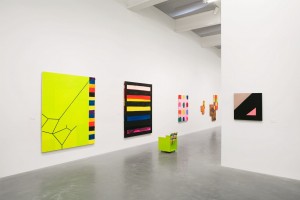
The New Museum in New York hosted the Mary Heilmann retrospective, To Be Someone from October of 2008 to January of 2009. If you’ve ever heard of Mary, you know that her artwork, and personality are exceptionally generous. Her paintings, ceramics and sculpture are nonchalant yet host some of her most personal experiences. Mary Heilmann chose to provide her audience with a gallery experience that is real and unpretentious. Therefore, she invited us to stay and relax in her rolling chairs (picture above from Heilmann show catalog), which resemble her paintings with bold colors and matter-of-fact construction. The chairs provide an experience that promotes the creation of new memories, and revelations in both art and life, by providing space and time for a casual conversation.
Sensations of sentiment and memory within the paintings were made more real and memorable because I visited the exhibit with a close friend. Art and life melted together in a way that I had never previously come across at a museum. The amicable qualities of the show allowed our thoughts to meander until we came to discoveries and realizations about the work. If there were no rolling chairs, or opportunities to stay and relax, we might have dismissed really important parts of the work by not giving the paintings time to seep into our own memories. The chairs encourage and invite you to get to the meat of things.
While rolling from painting to painting, feeling at home, we giggled and chattered, taking it all in, as a security guard approached, to remind us that, “the chairs are art too.” As if we were unaware, as though we didn’t understand! In no way were we being aggressive or disrespectful toward the chairs or the show, but he felt the need to reinforce this; he has to do his job and I understand. Simultaneously, a middle-aged man in a very serious trench coat entered the gallery, from the elevator. He marched by us with a huff of disgust and grumbled, “Stupid kids from the suburbs.” For a moment we became quiet, looking at one another.
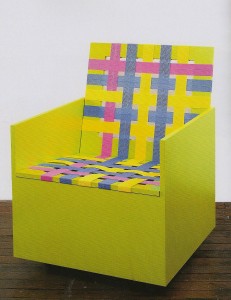
How does enjoying oneself in a museum make you seem stupid. We were in the company of interactive sculpture that you are meant to engage with. How also is it possible that being from the suburbs, and being young adults, “kids,” is an explanation for one’s idiocy for sitting in chairs made by an artist? This man was at the museum for the Mary Heilmann show, and he didn’t understand what it was about. There was no love, sentiment, or generosity in his demeanor. Maybe this can be blamed on being middle aged and living in New York? To come to this show with a lack of understanding so great that you scrutinize the audience for appreciating the work is to undermine the effect of the work on your person, and to misunderstand the entirety of her life’s work.
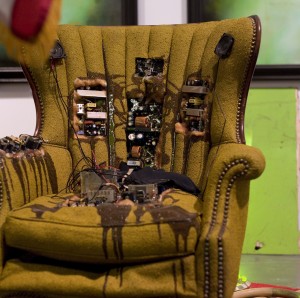
Upon entrance to the lobby of the Younger Than Jesus show, you are immediately made aware that this show and it’s audience are different. The Jukebox plays The Clash’s “Spanish Bombs” as people mingle and hang out in the café and bookstore area. The museum’s exhibition spaces had much the same atmosphere. People were hanging out, and having fun, while maintaining their intellect.
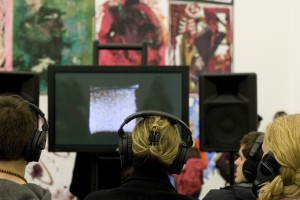
It is a thin and unfair assessment that the most important aspect of the experience of Generation Y is growing up with technology. In fact, technology seems to be an obsession for those who did not grow up with with it. Those of us who have been exposed to cable tv, computers, video games, and cell phones throughout our lives are more apt to consider these to be tools in the way we think of a drill or hammer. Millennials are not perpetually in awe of the machines, which we typically take for granted. As a Millennial artist, I do not believe work researched by the curators and selected for this show accurately represents me. However, unlike in my Mary Heilmann experience, I do find that the attitude of the audience, artists and curators in the show embody an openmindedness in research and presentation that is important to my generation.
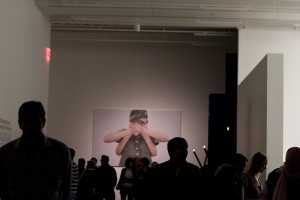
This second experience at The New Museum, with its bustling, amicable crowd has given me hope that there are real people who are comfortable in giving real, candid reactions and projecting inclusive attitudes toward other people and the artwork. This we can attribute to the curators’ unfussy installation and unpretentious display of the work. Lauren Cornell, Director of Rhizome and New Museum Adjunct Curator; Massimiliano Gioni, Director of Special Exhibitions; and Laura Hoptman, Kraus Family Senior Curator, are responsible for narrowing down the 500 artists suggested for the exhibition, as well as curating the show. Through their vision, we find ourselves able to interact with the artworks, surrounded by them, and invited to approach them through their nonchalant placement.
As we find ourselves in a world whose survival depends more and more on empathy, it is important for public establishments to set standards by offering time and repose, to encourage political and social change through sensitivity and understanding.






